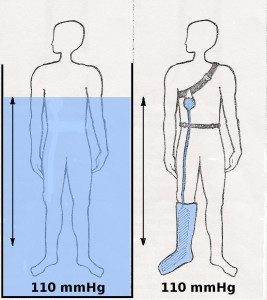This is a compression system which exerts high external pressures on the leg and is painless. The pressures achieved are much higher than those that can be obtained using stockings or bandages and are easily tolerated by the patient. The situation is similar to standing in water up to shoulder height. Whilst underwater, prominent varicose veins disappear to become gutters in the skin. Such strong compression is unachievable using standard stockings. Furthermore, hydrostatic compression has been shown to heal venous ulcers resistant to standard compression therapy. Research into developing a suitable prototype is eagerly awaited.
ALFRED OBERMAYER We have created a “dynamic hydrostatic compression system (DHCS)” which exerts a pressure that depends upon the height of a hydrostatic column of fluid. Basically, a fluid reservoir is attached at shoulder height by a thin tube to a boot. The system is dynamic because the vertical height of the column adjusts to the degree of ambulation. Standing or walking will create the maximal pressure whilst it will be diminished lying down. The principle of the DHCS relies on the Law of Pascal because the pressure exerted depends upon the height of the reservoir, irrespective of the diameter of the tube or the volume of the boot. The system is painless because the Law of Laplace does not apply in fluid system enclosures where there is uniformity of pressure and wall tension. This is unlike stockings which exert vector and radial forces that depend upon the contour of a leg. We are working hard on solving some technical problems such as leaking or fixation. Our first tests are very promising.
